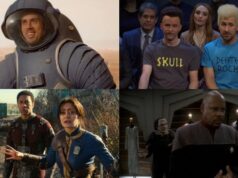
It’s better if we just get this out of the way now: Yes, Solar Opposites is an extremely Justin Roiland joint, but to call it a Rick and Morty knockoff is to miss the point of the show, which is to dunk specifically on humanity, rather than existence as a whole. See? They’re different. Ish.
The premise of Hulu’s Solar Opposites is one that’ll ring generally familiar to anyone who’s ever picked up a Superman comic. As the planet Schlorp is on the brink of destruction after being struck by a meteor, Korvo (Roiland), his co-worker and kinda sorta-maybe-life partner Terry (Silicon Valley’s Thomas Middleditch), and their ersatz children Jesse (Mary Mack) and Yumyulack (Sean Giambrone) are flung into space with a cute but unsettling being known as a Pupa (voiced by Solar Opposites co-creator Mike McMahan’s son Sagan). Their mission is simple enough. They need to find a planet to terraform and, ideally, turn into a new paradise for their people. Much to their (at least initially) collective dismay, they end up crash landing somewhere in the Western chunk of the suburban United States.
Despite the fact that they’re all hairless, plant-based lifeforms ranging in shade from pale grey to deep green, Solar Opposites’ core family blends right into their new surroundings—and not because of any sophisticated technology or that people are too dumb to realize that they’re aliens. No one really makes a fuss about them because they simply don’t care that first contact has been made with species from a different planet. That deeply apathetic energy is a fundamental part of the show’s sense of humor.
Even though the Schlorpians spend the bulk of their time trying to present as humans, they truly never fool anyone, which is one of the ways that Solar Opposites creates opportunities for its main characters to experience what the core of human prejudice is like. Because they’re smaller, Yumyulack and Jesse attend school, where their peers and teachers openly mock them with blaster-focused alien stereotypes. Korvo and Terry fare better in a technical sense, but at every turn, they’re presented with a blend of dullards and sensible people who simply don’t have the time or patience for their inability to grasp Earth’s cultures.
Much as they’d all hate to admit it, the Schlorpians have to try to find a way to insinuate themselves into human society because their mission was specifically to find hospitable, but uninhabited planets. They all still feel perfectly fine destroying the planet by helping the Pupa grow into its final form in which it will become a world-killer, but for the time being they all understand that they’ve just got to get by.
Where Rick and Morty finds its strengths in placing its characters into strange, mindbending worlds, Solar Opposites instead beats its characters over the head with the mundane parts of humanity in a way that highlights how not great we are as a species. When Korvo and Terry realize that the beloved character from a children’s cartoon isn’t real, the pair sink into an existential spiral that leads to the question “Is Friends real?” It’s the sort of joke that works because while the aliens are losing their shit, one can sensibly watch and comment “No, Friends is not real. Both in the sense that it’s a fictional show and its depiction of New York City was wildly inaccurate.” Also, because this is important, when the aliens get stressed out they sweat tiny sentient beings that get up and dance before skittering away, presumably, to die.
It’s really only in the series’ overarching subplot—which stems from the kids’ propensity for using a shrink ray on their enemies before storing them in containers in their room—that the point of the show is laid bare in a horrific way. To Jesse and Yumyulack, the tiny humans are just screaming things, but for each of the people they’ve zapped and entrapped in an interconnected wall of hamster carriers, the world becomes a brutal, vicious place where one has to fight unless they want to be killed by someone savage enough to want to survive.
As the aliens all try to figure out out how to perform like humans, the wee caged people become embodiments of the ugliest, basest form of humanity that their captors never really get a grasp on. There is murder and horror and enough bloodshed to make Game of Thrones tip its hat, but because it’s all happening on such a small scale, no one but the people involved witness it, and it’s all devastating in a strangely poetic way.
The thing is, though, Solar Opposites never really tries to force you to understand that aspect of itself in the way that Rick and Morty screams and shouts about how nihilistic it is. Instead, Solar Opposites just puts the ugly, upsetting thing on the table and leaves you to pay attention to it or ignore it. That choice is, in and of itself, a part of what the show’s going for—to illustrate that we all have the ability to choose what kinds of people we want to be. The unpleasant thing is that when left to our own devices, more than a few of us choose the darker, more insidious option.
All episodes of Solar Opposites are currently available to watch on Hulu.
For more, make sure you’re following us on our Instagram @io9dotcom.
Source: gizmodo.com








